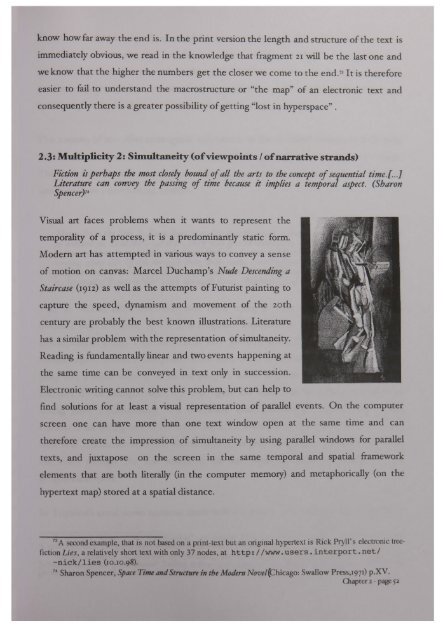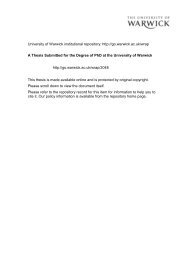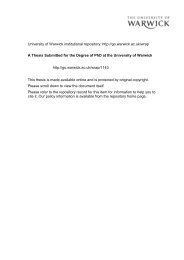From Page to Screen - WRAP: Warwick Research Archive Portal ...
From Page to Screen - WRAP: Warwick Research Archive Portal ...
From Page to Screen - WRAP: Warwick Research Archive Portal ...
You also want an ePaper? Increase the reach of your titles
YUMPU automatically turns print PDFs into web optimized ePapers that Google loves.
know how far away the end is. In the print version the length and structure of the text is<br />
immediately obvious, we read in the knowledge that fragment 21 will be the last one and<br />
we know that the higher the numbers get the closer we come <strong>to</strong> the end.» It is therefore<br />
easier <strong>to</strong> fail <strong>to</strong> understand the macrostructure or "the map" of an electronic text and<br />
consequently there is a greater possibility ofgetting "lost in hyperspace" .<br />
2.3: Multiplicity 2: Simultaneity(ofviewpoints / ofnarrative strands)<br />
Fiction is perhaps the most closely bound ofall the arts <strong>to</strong> the concept ofsequential time.[...]<br />
Literature can convey the passing of time because it implies a temporal aspect. (Sharon<br />
Spencer)':<br />
Visual art faces problems when it wants <strong>to</strong> represent the<br />
temporality of a process, it is a predominantly static form.<br />
Modern art has attempted in various ways <strong>to</strong> convey a sense<br />
of motion on canvas: Marcel Duchamp's Nude Descending a<br />
Staircase (19I2) as well as the attempts ofFuturist painting <strong>to</strong><br />
capture the speed, dynamism and movement of the zoth<br />
century are probably the best known illustrations. Literature<br />
has a similar problem with the representation ofsimultaneity.<br />
Reading is fundamentally linear and two events happening at<br />
the same time can be conveyed in text only in succession.<br />
Electronic writing cannot solve this problem, but can help <strong>to</strong><br />
find solutions for at least a visual representation of parallel events. On the computer<br />
screen one can have more than one text window open at the same time and can<br />
therefore create the impression of simultaneity by using parallel windows for parallel<br />
texts, and juxtapose on the screen in the same temporal and spatial framework<br />
elements that are both literally (in the computer memory) and metaphorically (on the<br />
hypertext map) s<strong>to</strong>red at a spatial distance.<br />
73 A ccond example, that is not based on a print-text but an original hypertext is Rick Pryll's electronic treefiction<br />
Lies, a relatively short text with only 37 nodes, at http://www.users.interport.net/<br />
-nick/lies (10.10.98).<br />
74 Sharon Spencer, Space Time andStructurein the Modern Novel(Chicago: Swallow Press,I97I) p.XV.<br />
Chapter 2 - page 52





